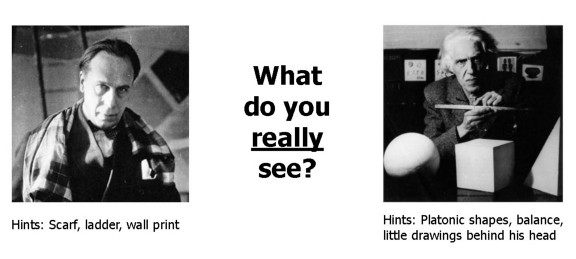Tonight’s fight! Van Doesburg vs J.T.G.
This Essay discusses the work of the artists Theo van Doesburg & Joaquin Torres García using Imaginational Theory. An introduction into Imaginational Theory can be read here -> {Theo van Doesburg} : Introduction into Imaginational Theory.
Disclaimer: This work can only be followed with a strong interest in art, theory & imagination. To fully understand the boxing match, you must do some self-study.
Grade Difficulty: Medium, Fitness Level: High
In 1929, just before his death, the Dutch artist Theo van Doesburg had a letter correspondence with his intellectual counterpart, the Uruguayan artist Joaquin Torres García (J.T.G.). Both artists were residing in Paris at that time. This argument is key in understanding the nature of abstract art.
I will prepare the blueprint for le nouveau plan. — Theo van Doesburg to Joaquin Torres-Garcia on May 28, 1929
Theo van Doesburg, responsible for the foundations of De Stijl movement in the 1920s took an interest in forming a new abstract-art movement in 1930: Art Concret (AC), previously known under the working title Groupement 6,6.
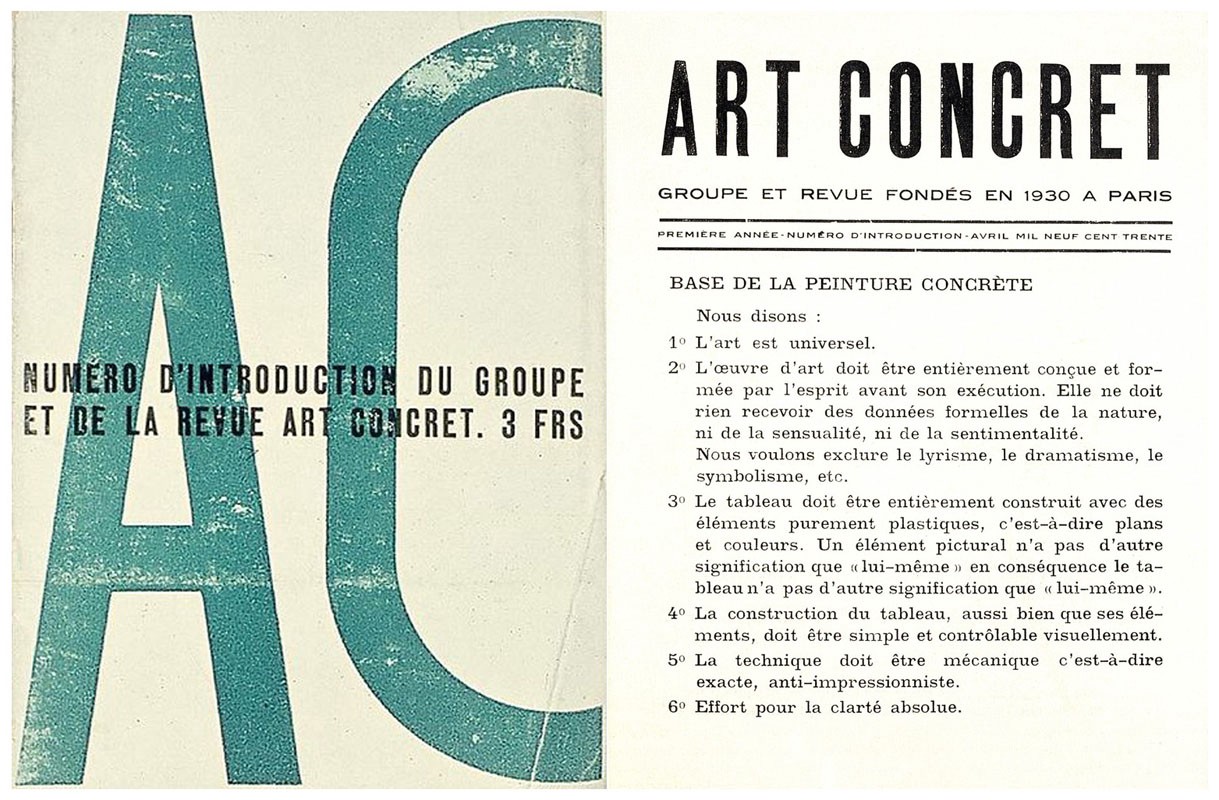
He invited J.T.G. to join this group of abstract artists but couldn’t convince him to come along. With Art Concret, Theo van Doesburg formulated a systematic six-point thread with the definition of abstract art.
“THERE’S NOTHING TO READ IN PAINT, ONLY SEEING”, for art has grown up — VD, Towards white painting, 1929
It would dispel all figurative notions and form a block against the uprising Surrealist tendencies. A very exclusive approach, something that Torres García was all against.
J.T.G. himself would make use of figurative characters, inside his abstract geometric compositions. He was against the split-up of the abstract artists in two groups; those who incorporate the figurative and those who work in purely geometric manner.
Even though J.T.G., in the early days, was heavily influenced by the work of De Stijl movement, he soon later, through studying art from ancient civilizations, realized that this New-Abstract-Art-Wave was embedded in human nature. This new wave was just a re-discovery of a forgotten notion about the essence of abstraction, previously visualized in the work of the ancient people.
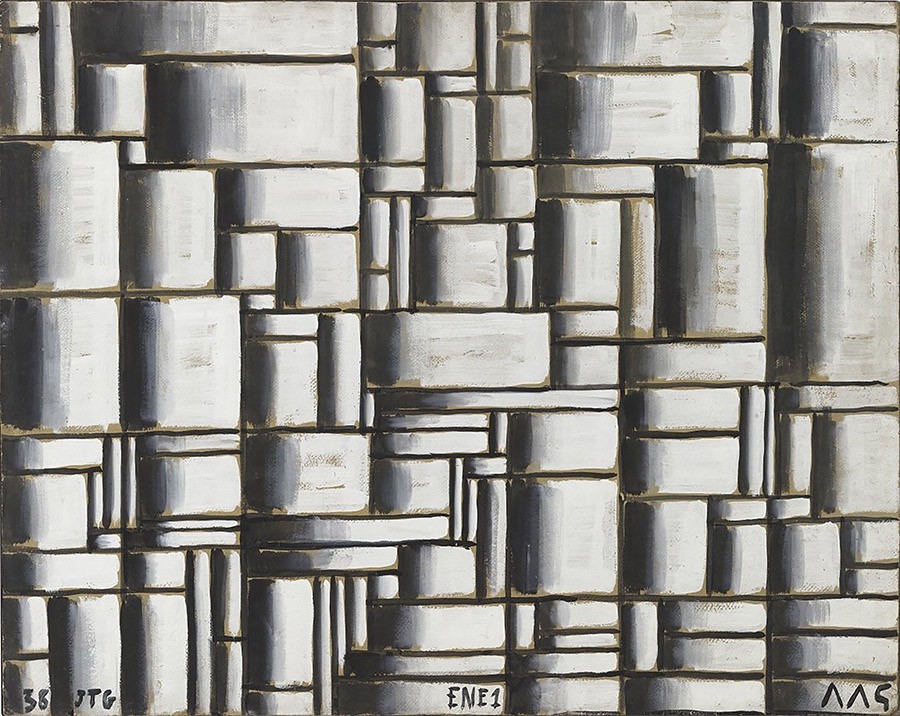
J.T.G. gathered with the artist Michel Seuphor and formed another, more inclusive group of artists called Cercle et Carré (Circle & Square). This group included the headliners Kandinsky & Mondriaan, but also women.
AC was instead a 6-men-only club.
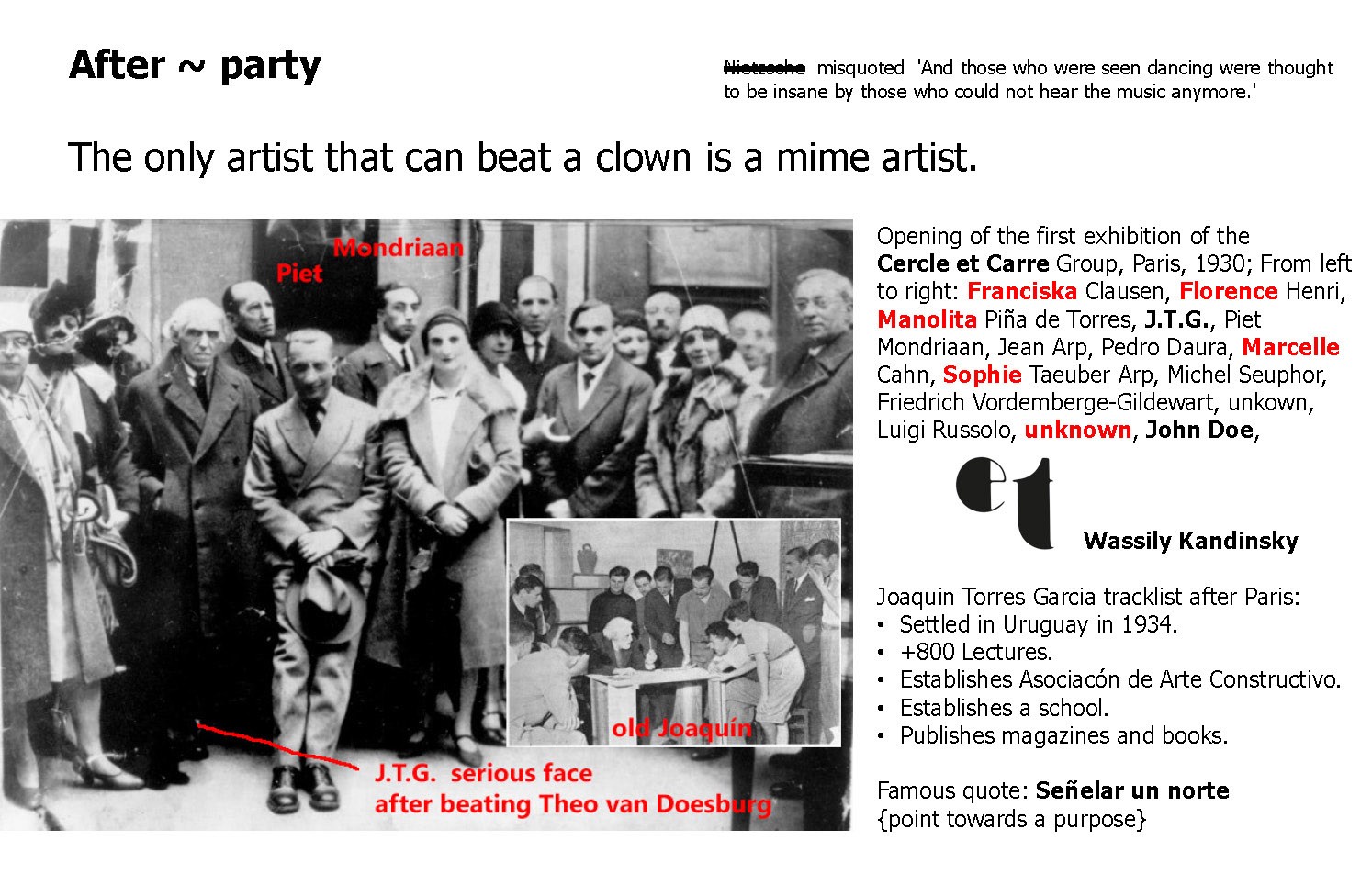
Both movements had a very short lifespan. Art-Concret was formulated through one magazine, in 1930, Cercle et Carré had one exhibition, in Paris 1929. After this short split-up, both parties came back together, and unified again through Abstraction — Création.
Pyramidical Construct; Idea-Manifesto and a search for the universal spirit
These schemes can be considered as a short lead-up, describing both positions, considering the issue of abstraction in art.
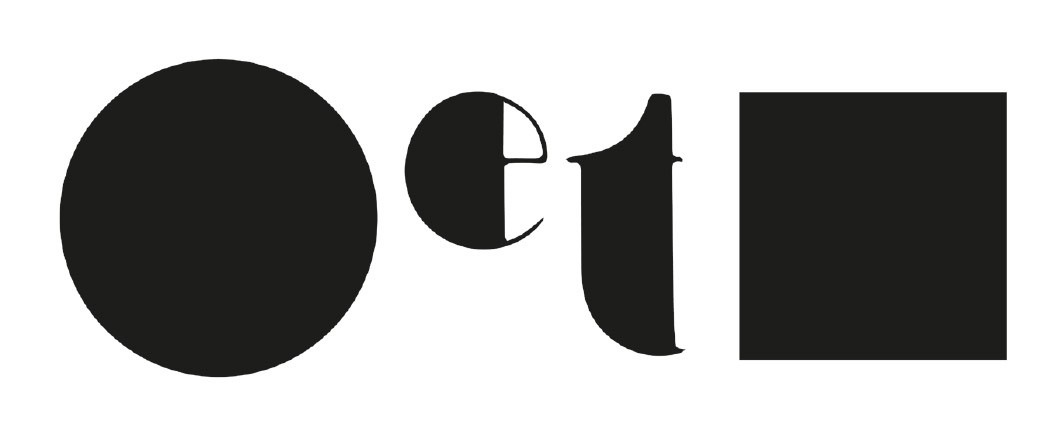
Excerpt Abstract : Reality [Language], Pyramidical Construct 1/5, M.© 2018
When we look closer to the design of the logo for Cercle et Carré (1929) we can find some interesting features. The surface of a circle can never equal the surface of a square {quote by H.}, and the “et” balancing in-between is “characteristically” shaped. This logo represents the dualistic ~ nondualist quandary of being-in-reality.


Theo van Doesburg would formulate art as a pure-pyramidical-entity, superposing the quandary of being-in-reality.
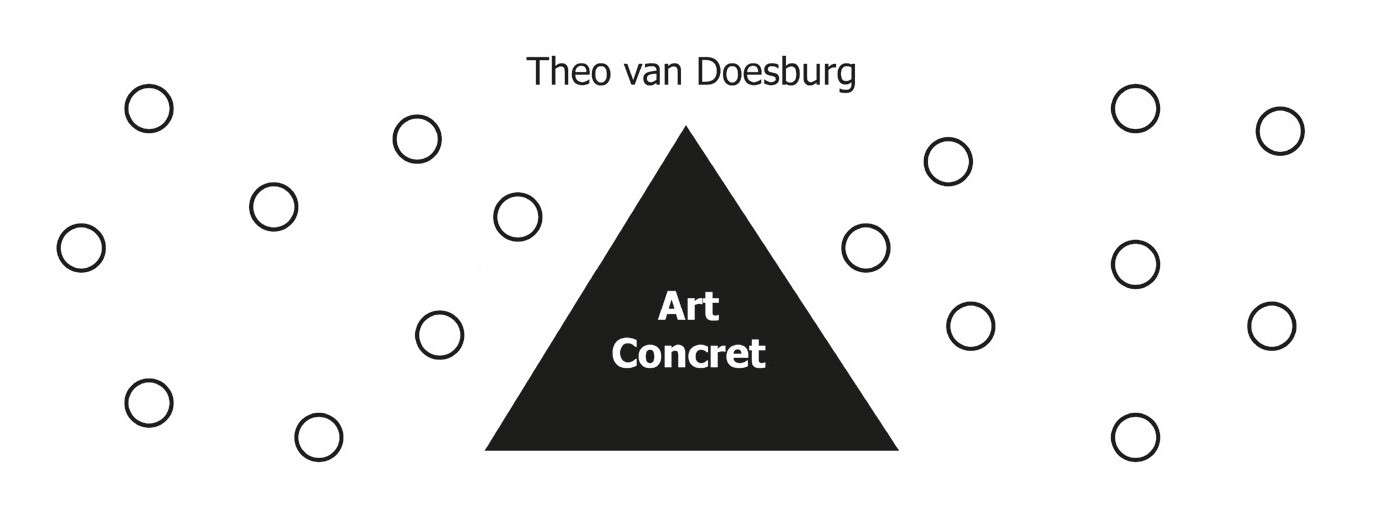
The manifesto Art Concret (1930) was as a pyramidical construct. A manifesto as Idea which describes the universal spirit as a singular truth, reaching for a state of 100% purity.
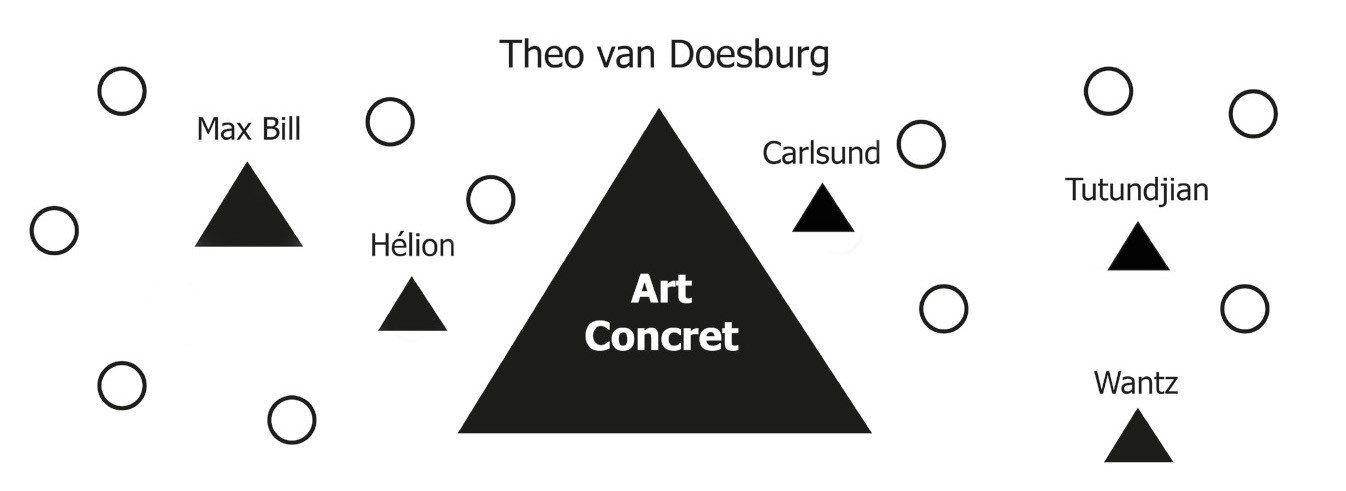
The manifesto Art Concret was a prophetic manifesto with nihilistic conviction; a tool for conversion, not for dialogue. Hence the six-point set-up. (Artists Friedrich Vordemberge-Gildewart & Walmar Schwab didn’t sign it, eventually)
Abstraction — Création; Memberlist
One year later both parties, after this short split-up, united again, through an initiative by Georges Vantongerloo, pushed by Jean {Hans} Arp in a get-together at the Van Doesburg House, located close to where the existentialist Jean-Paul Satre grew-up. In the outskirts of Paris, Meudon.
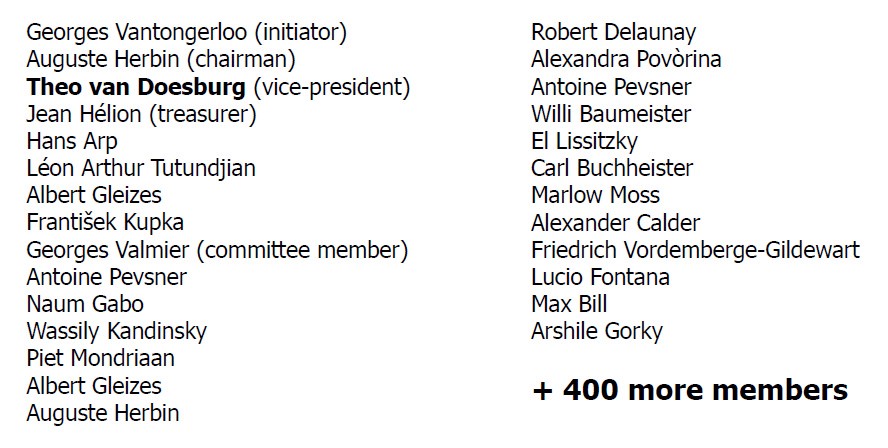
Abstraction — Création, 1931 was a list of people working on the ideas of abstraction; fusing Art Concret + Cercle et Carré + former de Stijl, expanding the platform for abstract art all over the western world.

In 1934 Joaquin Torres García returned to Uruguay. The following year he founded the Association of Constructivist Art in Montevideo and gave the pioneering lecture; “The School of the South”, which argued for the importance of both South & North American schools of modern art.
Were the Incas constructivists?
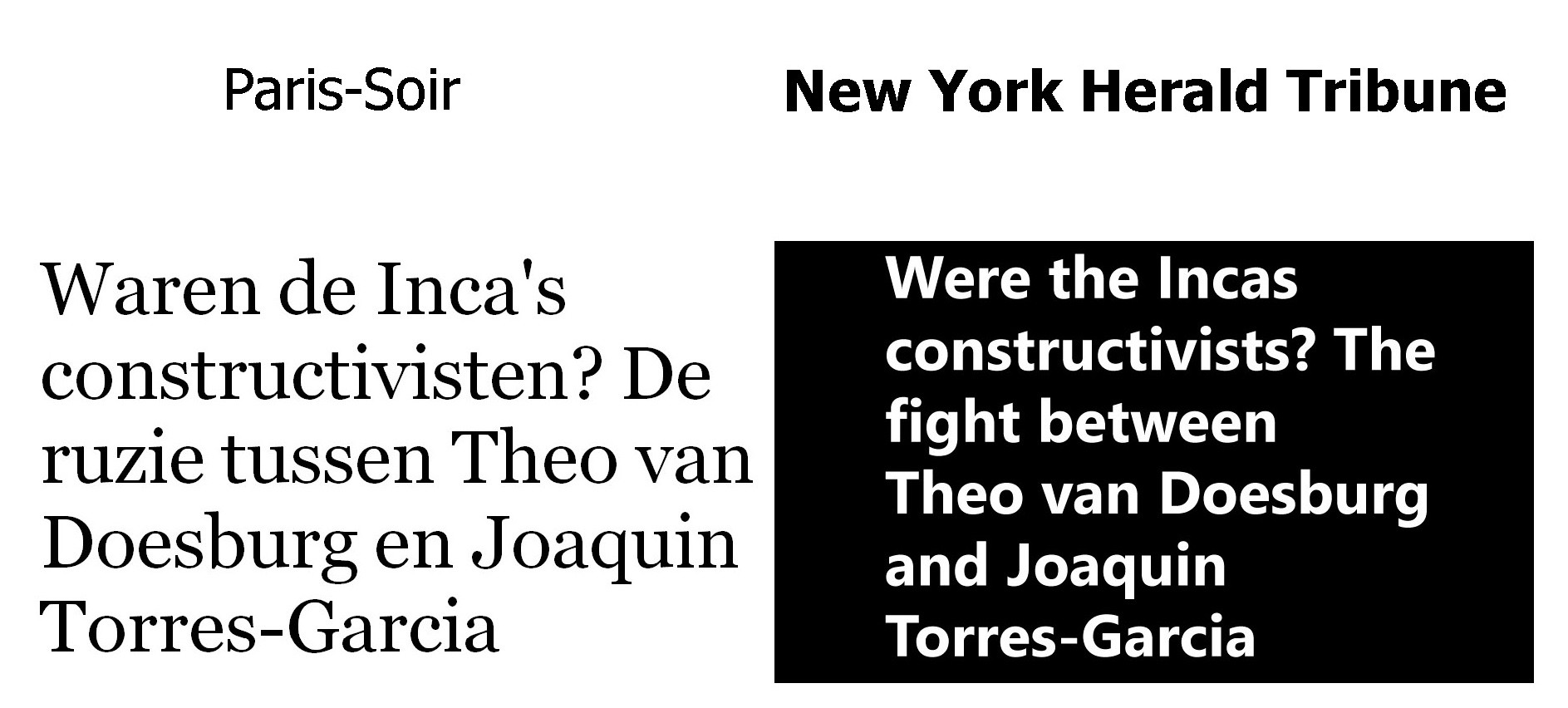
So, what was this fight between Theo & Joaquin about? This is not merely a stylistic stance towards abstract art. It deals with much more, with perception, with the nature of reality. This is a moment in which visual art slips into science, into philosophy, into imagination.
To understand the thinking-processes of these both men, and value their positions I made use of a technique I coined Imaginational Theory [2024 book release].
An imaginary fight of Abstract : Reality starring these two characters; Theo van Doesburg in one corner vs. Joaquin Torres Garcia in the other. I focus on key-frames in their lifetime, while dealing with questions of abstraction. By going through the rounds, I explain the nature of their actions; the scientific~philosophical framework.
Abstract : Reality — Theo vs JTG
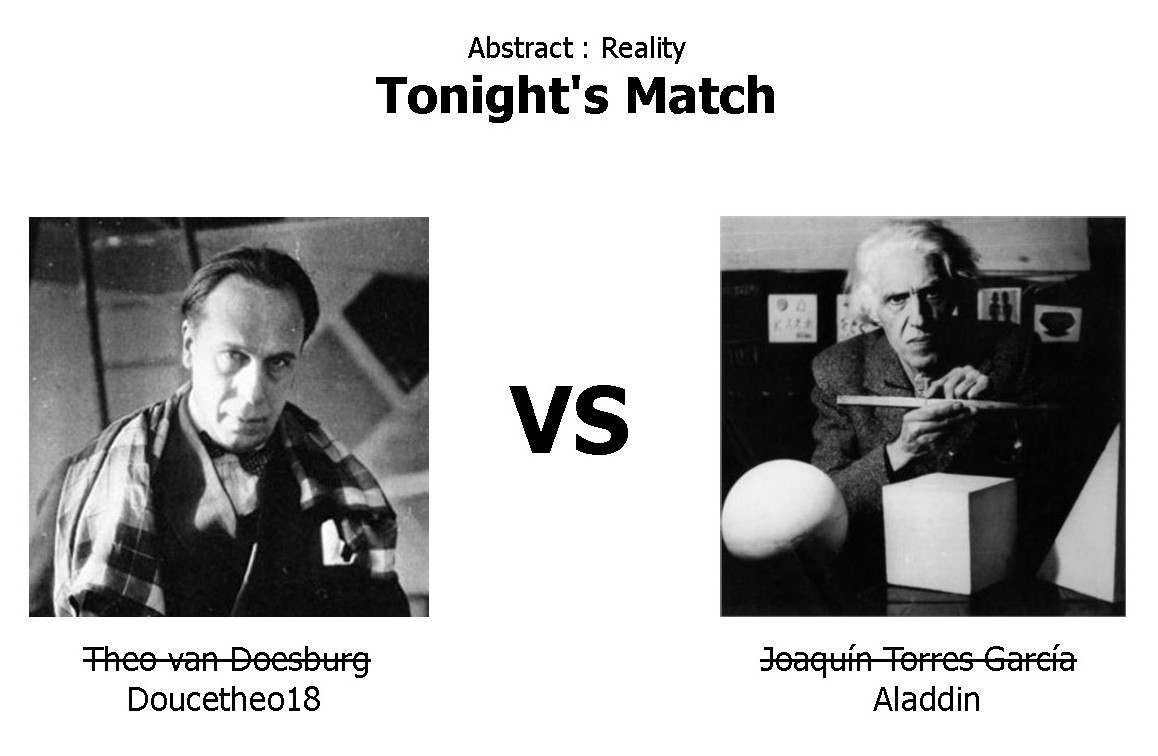
In the left corner with his designer scarf, we have the ground-breaking artist, born in 99, also known by a very few people as Douchetheo18. In the right corner we have the 15 years older-grand-master J.T.G., better known for insiders as Aladdin.

Let’s look at their specs.

Doucetheo18 has been famously known as a publisher of art-magazines, such as the obscure Dadaist Mécano, the world-famous Dutch de Stijl (with over 200 readers at his peak times) and his most-essential publication; Art Concret.
AC’s 6-point-strategy was soon later recognized and fully utilized by the only known Swiss Bauhaus student Max Bill (Read more about it in Hansegger : A Question of Style).
Doucetheo18 played multiple rounds of Abstract : Reality, mostly against his fellow Dutch man Mondriaan. Mondrian (he lost one a during the Parisian rounds) was far-ahead with winning, after his all-time classical move, the impressionist-tree-into-abstraction-upper-cut. Nevertheless, Mondrian lost progress in the later rounds, by repeating moves and making slight alterations of previous combinations.
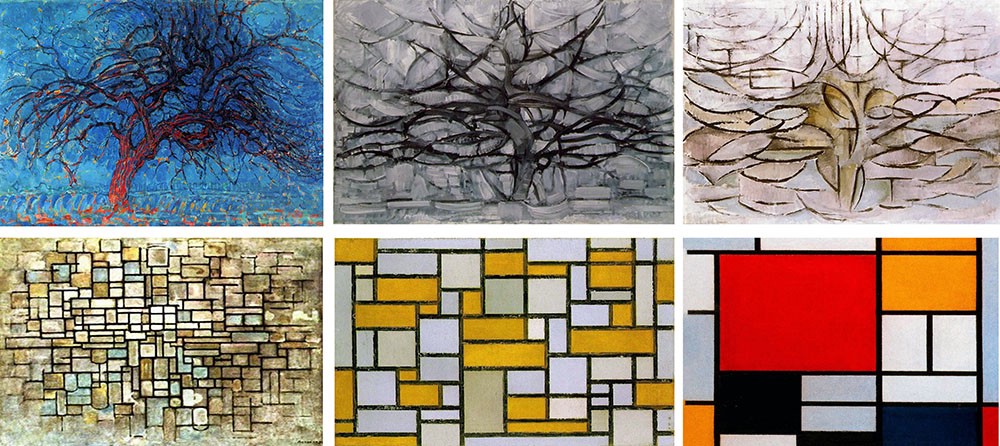
Mondriaan progressive evolution throughout the match, impressionist-tree-into-abstraction-upper-cut 1908–1927
Douchetheo18 knew how to cut corners, rapidly he jumped throughout the match, introducing new-techniques, such as the Cow 4-into-1 combo, and the diagonal moving into imaginary space, just outside the canvas. (shown in round #4)

Mondrian’s defeat went unrecognized by the audience, but can be traced back in his last “unfinished-diagonal-hanging painting” Victory Boogie Woogie. Theo’s last accomplishment was the execution of his own house.
Coaches are his life-long friend, supporter and pen-pal-poet Antony Kok (mental), and his 2nd wife, the accountant Lena Millius (physical). Doucetheo18 practiced in his early days with stained-glass-windows-for-church-design.
Aladdin was more a novelist by nature, publishing books such as “The City without a Name” & “Traditions of the abstract man”. Although he created one magazine; Cercle et Carré. The 2nd edition of C & C was mostly spread-and-read in Uruguay.
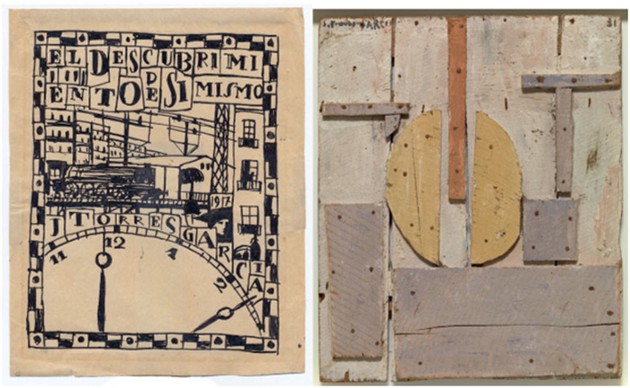
Aladdin was a quiet type, who only trained and never picked a fight, until he met Doucetheo18. Most of his training consisted of wall painting and building sculptures from trash (old wood). He also helped the Spanish architect Gaudí with the design of stained-glass-windows for the Sagrada Familia. At the end of his life, he built his own wall. His coaches are his 3 children.
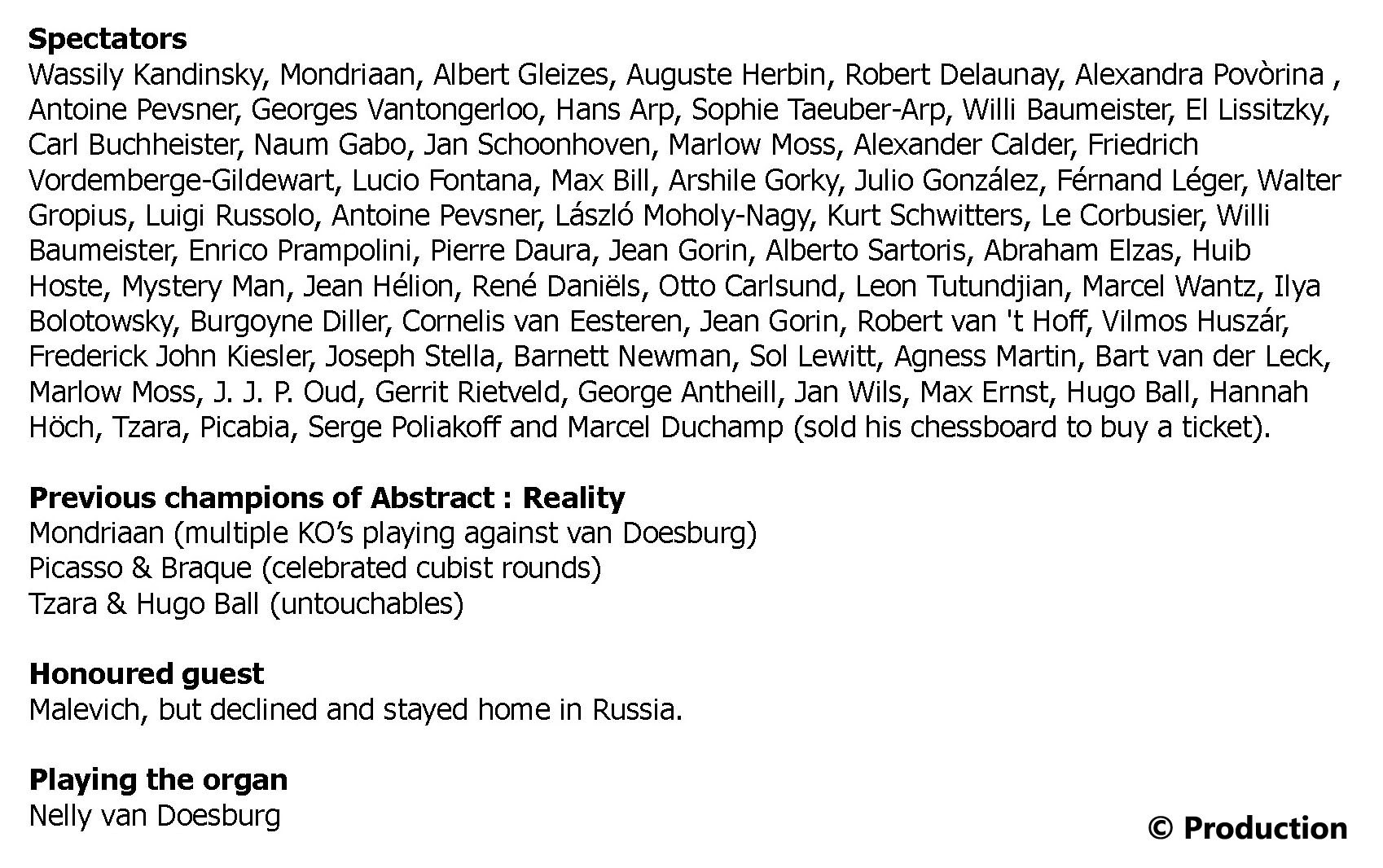
Many people arrived in Paris to see this fight. Even giants such as Tzara & Ball (untouchables), Mondriaan (former champion), Picasso & Braque (celebrated cubist rounds) were all present at this special event.
Just before the fight J.T.G. gave Picasso one of his paintings. A gift for his former training. Picasso, a poor man at that time, used the canvas.
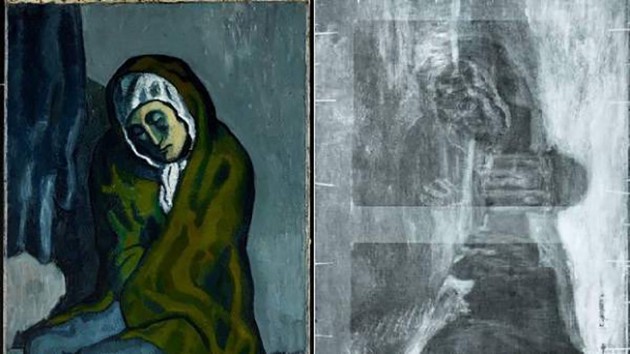
He over-painted J.T.G.’s temple in a landscape with something else. The blueish figure on the painting is also known as “‘Poverty crouched’.” Read more about poverty crouched in Jan Verhoeven; a forgotten legacy.
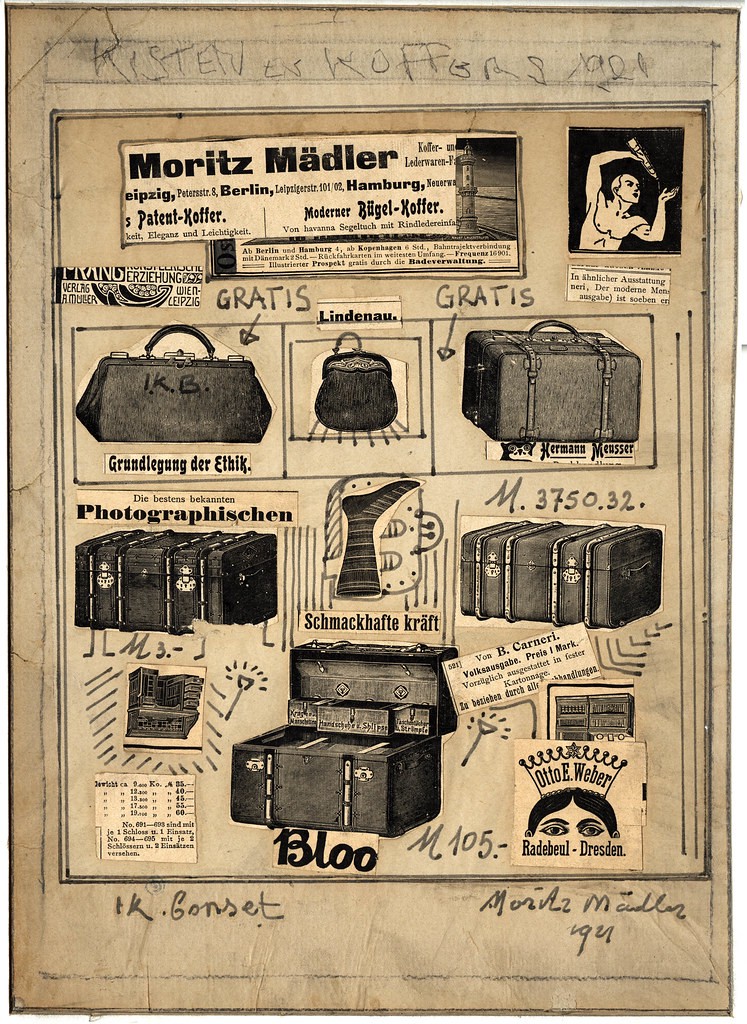
Braque used the newspaper-cut-out-of-the-boxrs-article of the fight (designed by Theo) in one of his cubist collages. Nelly, the 3rd wife of Theo, a musician, played the organ during the opening and the breaks.

Malevich, the first star of Abstract : Reality, who went undefeated for almost a decade, with his hide-and-seek-technique, such as “white on white”, declined the offer. He didn’t like to travel. (Read more about the impact of his work in Uniformity in Contemporary Design.)
Marcel Duchamp who worked as a librarian in a Parisian library, was short on money for the seats he wanted. He couldn’t afford the most expensive seats, the VIP front row seats, with his small librarian salary. He decided to sell his chessboard at the local market to buy the best seat. (See more about Duchamp in Abstract : Reality [Duchampian Chess].)

Small-side-note; Later Duchamp won a large sum of money by playing illegal-chess-games (under the personas Rose Selavy ~ Rose Mutt) in a Parisian basement. With the money he bought all the TV-rights of Abstract : Reality. The major profit generated, even these days, flows back to the Duchampian family, with headquarters all around the western world.
Read and see more about how the Duchamp-Way grew throughout the last century in Abstract : Reality (Rosebud).
Robert Ryman took VD’s advice given in his pamphlet “Towards white painting” very serious, his name appears all white on the guest list. He was honoured to arrive on time, coming all the way from the U.S of A.
The first thing Robert did — as a true American — when he arrived at the scène, is to let somebody take a picture of him; standing in front of a stand-in-picture of the empty boxing ring.
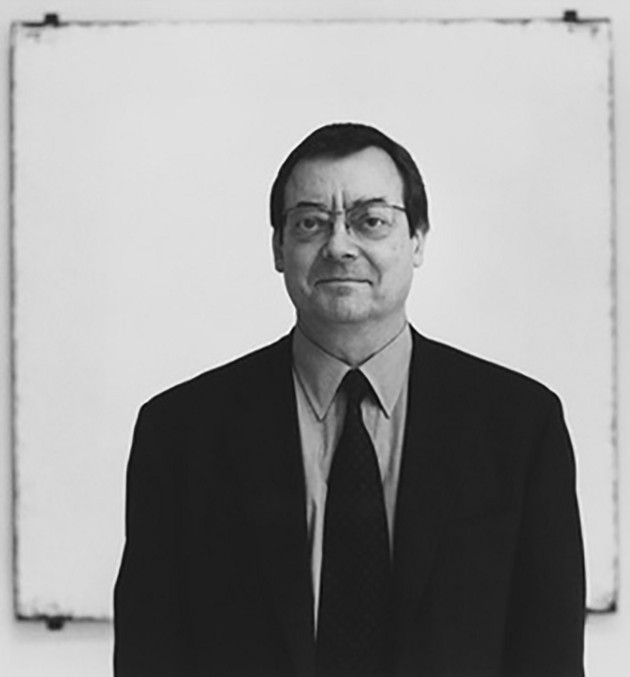
© [Cézanne Oranges] was responsible for the organization of this event.
“Let’s get ready to rumble!”
Round #1 Superhero-characters
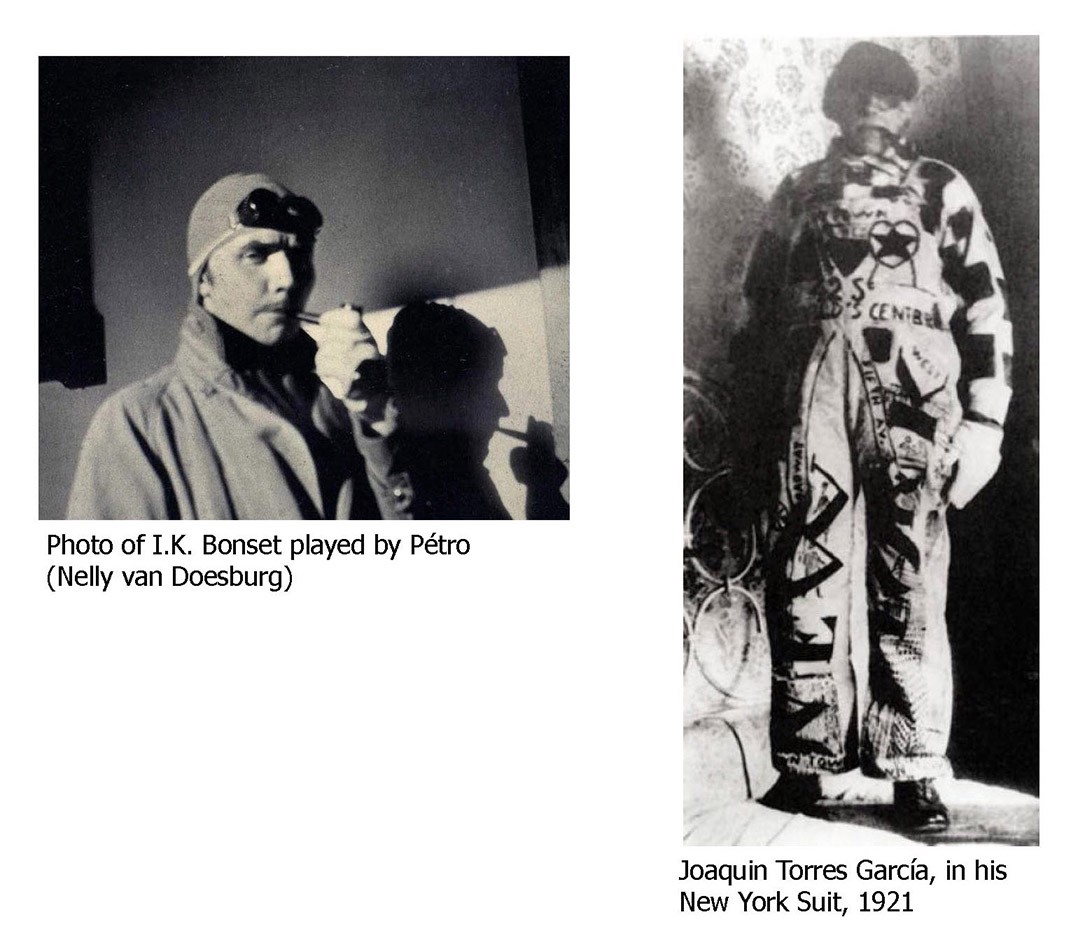
[I.K. Bonset] The first round is all about distortion. Theo shows up as his shadow I.K. Bonset; an abbreviation of “Ik ben zot” (NL) — I’m crazy (EN). But he didn’t project this shadow, it was his wife Nelly, playing the role of Pétro.
Theo his alter-ego I.K. Bonset is used as a [projection] to create confusion about reality.
M.: A character is used a projection.
M.: A suit (forms of fashion) is used as a projection.
[New York Suit] J.T.G. shows up in a self-made-costume with abstract shapes, signs and letters; about NY.
The ‘Idea’ of a suit is used as a [projection] to create confusion about reality. The suit is a smokescreen, it displays the modern city {recalling collective images of New York}.
#2 Morphing
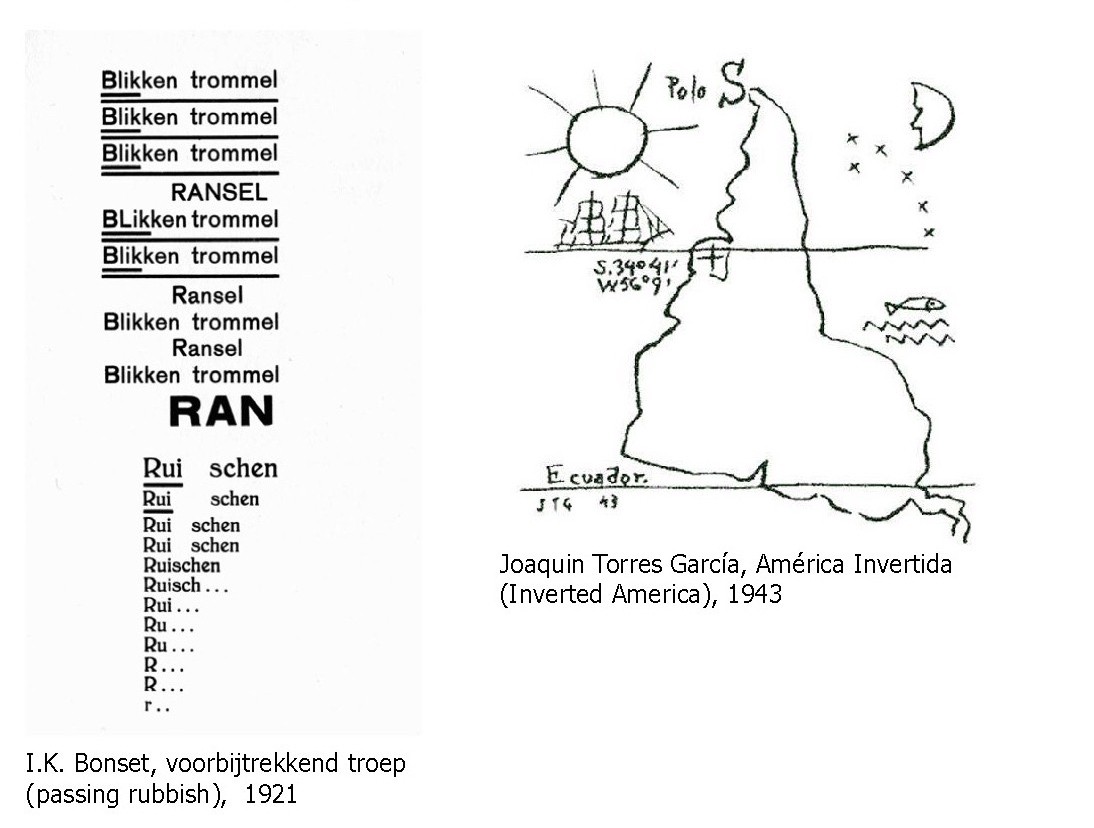
From distortion we move into a domain of morphing.
[Passing rubbish] VD : Combines the compositional elements of text and the sound-of-words to create a [projection] of reality. By reading the poem out loud not only the words, but also the sounds of the words create the feeling of a cart filled with trash passing by.
M.: Constructed feeling is created, through a new combination.
M.: Constructed meaning is created, through superposition.
[América Invertida] J.T.G. : {Map} Is a misconceived [projection] of reality. By inverting the map of South America, he points towards a new north; the south becomes the north.
#3 Modern revolt or ancient tradition
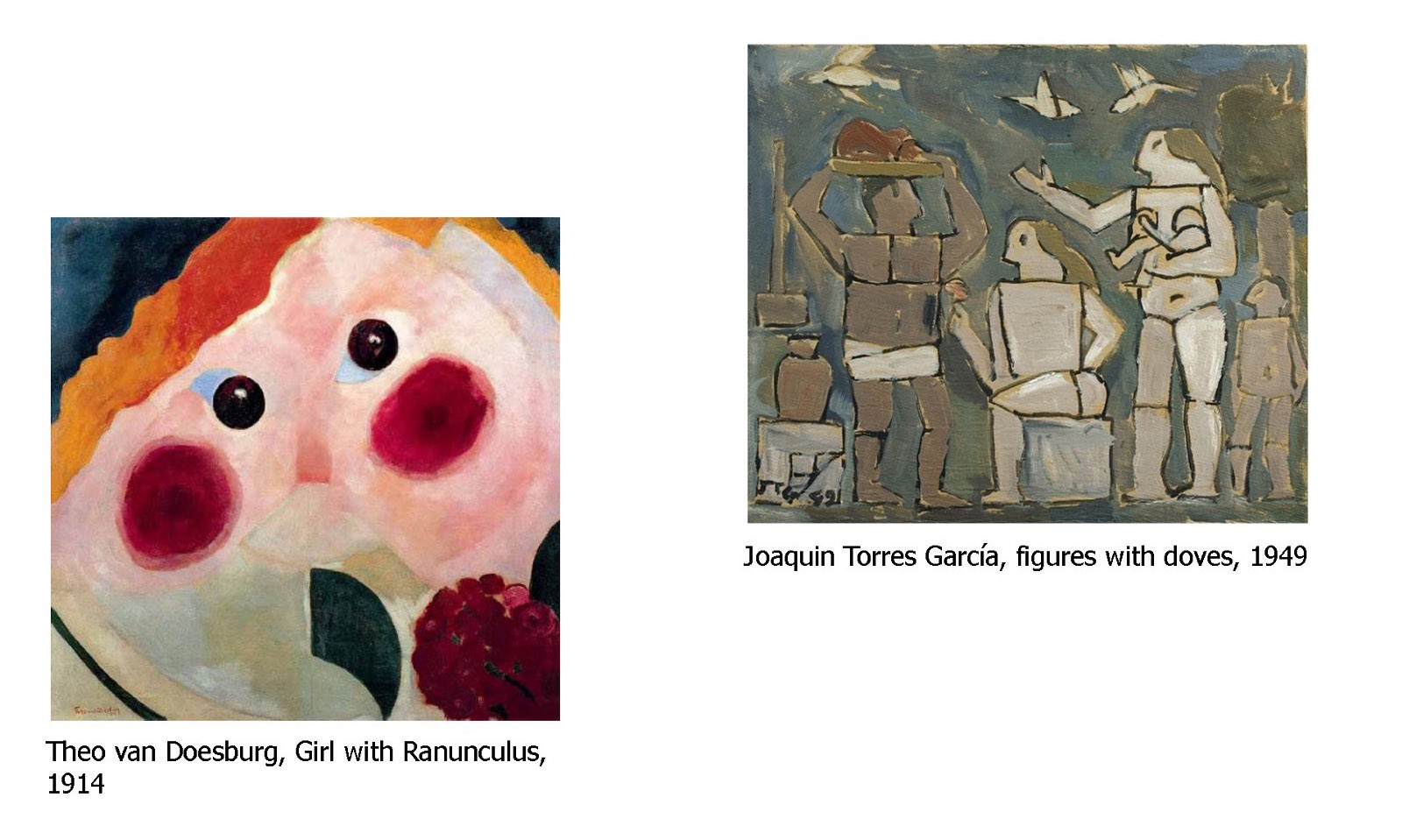
[Girl with Ranunculus] VD : This is one of Theo’s first true abstract works, still with expressionistic character. Transforming Kandinsky’s ‘Idea’ of expressionism into a construction. The painting was first set-up with pencil and a pair of compasses, later colorized.
M.: Technique [how it’s made] becomes an abstract instrument.
M.: Technique [how it’s made] becomes an abstract instrument.
[Figures with doves] J.T.G.: The traditions of fresco wall-paintings (which he made in the beginning of his life) are transformed into an abstract vocabulary of figures. The technique of painting a fresco on a wall sets the guiding lines.
#4 Between space & surface
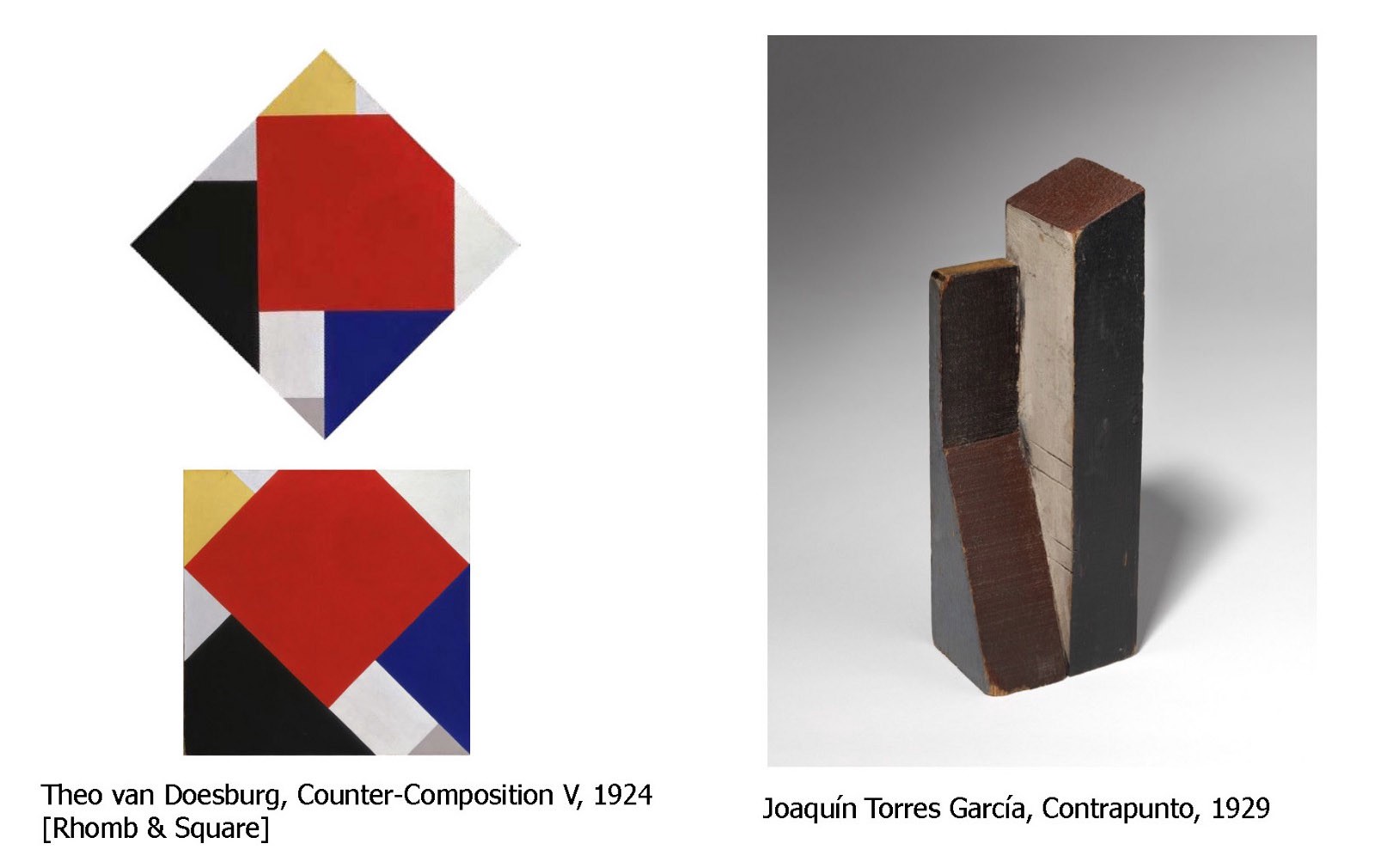
[Counter-Composition V] VD : Planes are moving outside the surface of the canvas, into imaginary space.
M.: By rotating the canvas, the viewer unconsciously tries to expand the image outside the borders of the canvas. The composition slips into imaginary space. An idea also shown in Rembrandt's painting; self-portrait with two circles. (I discussed this painting in Abstract : Reality[shadowplay])
M.: His wooden sculpture starts walking away into imaginary space.
[Contrapunto] J.T.G. : By introducing diagonal directions in his wood-made-abstract sculptures, the viewer projects ideas of movements into an abstract shape.
#5 Imaginary space or universal signs
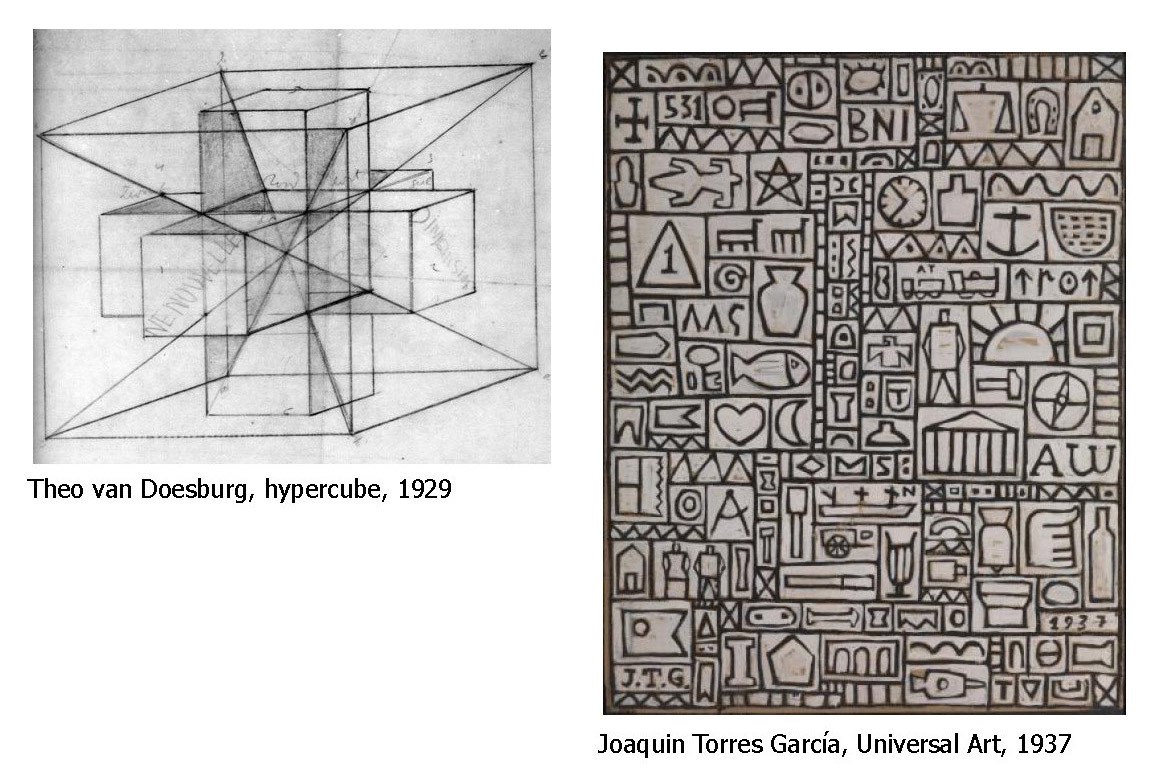
[Hypercube] VD : Endeavours in exploring and understanding the 4th dimension, in mathematical space.
M.: [imaginary visual space]
M.: [imaginary mental space]
[Universal Art] J.T.G. : Endeavours in exploring and understanding the 5th dimension in signs; already present in ancient civilization, like the Inca’s. By combining these ancient words, figures, and letters from ancient language-systems [Jungian Archetypes] with modern vocabulary J.T.G. creates a new mixture, thus so creating his own time-warping language.
#6 Wall or building
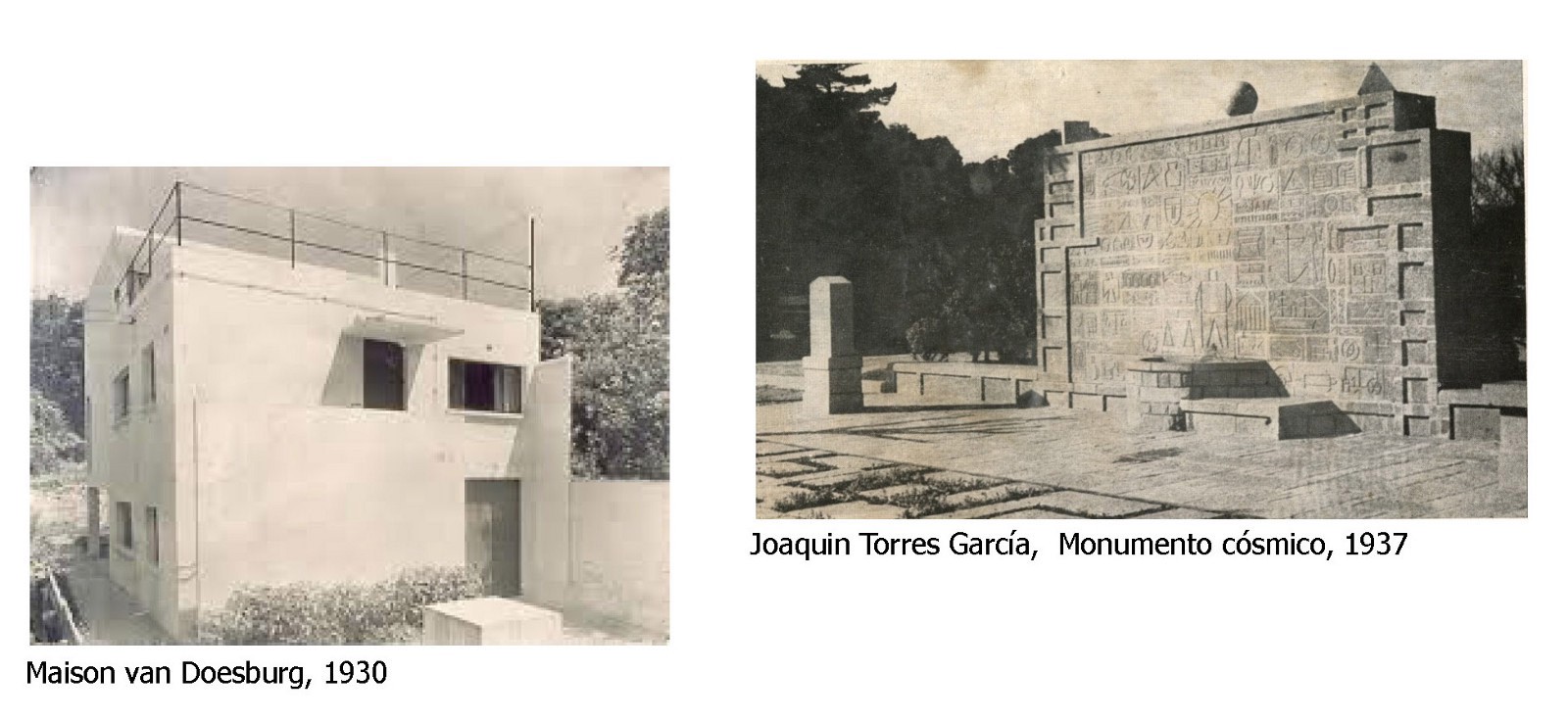
[Maison van Doesburg] VD : Ideal ‘Idea’ of abstraction; modulated shifting cubes facing a perfect third cube in the garden; the pedestal becomes sculpture, an ode to the highest order, the cube itself.

[Monumento cósmico] J.T.G. : Universal signs carved into the wall become a pedestal for the higher spirit, with the three platonic shapes placed on top [cube, sphere and pyramid].
A plaque on the ground nearby has inverted cardinal points carved in it, so south appears at the top and north at the bottom (inversion, pointing towards a new north).
- The wall has a secretly designed back-side. Naturally-formed-roundish-varying-coloured-boulders sticking out of the earthly red-coloured-surface.
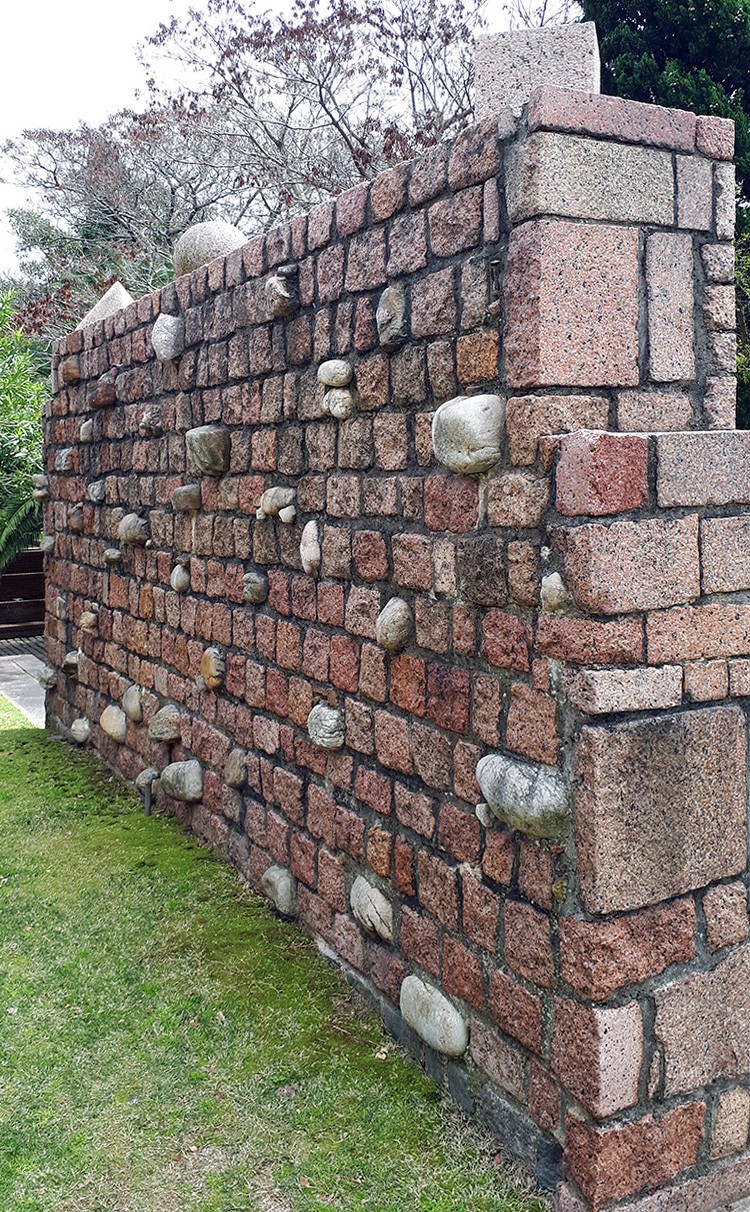
I arrived at the face of the wall. I reached out to touch it. It was hard, a stone-wall with no give and no apparent entry. I looked in all directions along the wall. At this moment I realized; This was it. I found it, the source of all meaning, the place where we all come from, and the place where we all end up.
The edge of the universe…
I realized that it’s nothing, just the end.
Not peaceful, but not-not peaceful either.
Just nothing.
For an initial moment I was devastated, but then…I was happy. I returned to civilization, humanity.
When I returned, people asked with great expectation what I found there. Is it the edge of the universe, is it heaven, is it the source of everything? I looked at the crowd and thought to myself for a moment, …
then I said: No…
There’s nothing.
Just a strange-light-reflecting-phenomenon-passing-through-stained-glass. Nothing to be concerned about.
Disappointed that the edge of the universe and the source of all meaning had still not been discovered, humanity continued to look elsewhere,
excited and hopeful that one day, maybe 1 day,
they would find it.
— M. , Towards prismatic thinking, 2025
Round #7 [Final Round] Biology
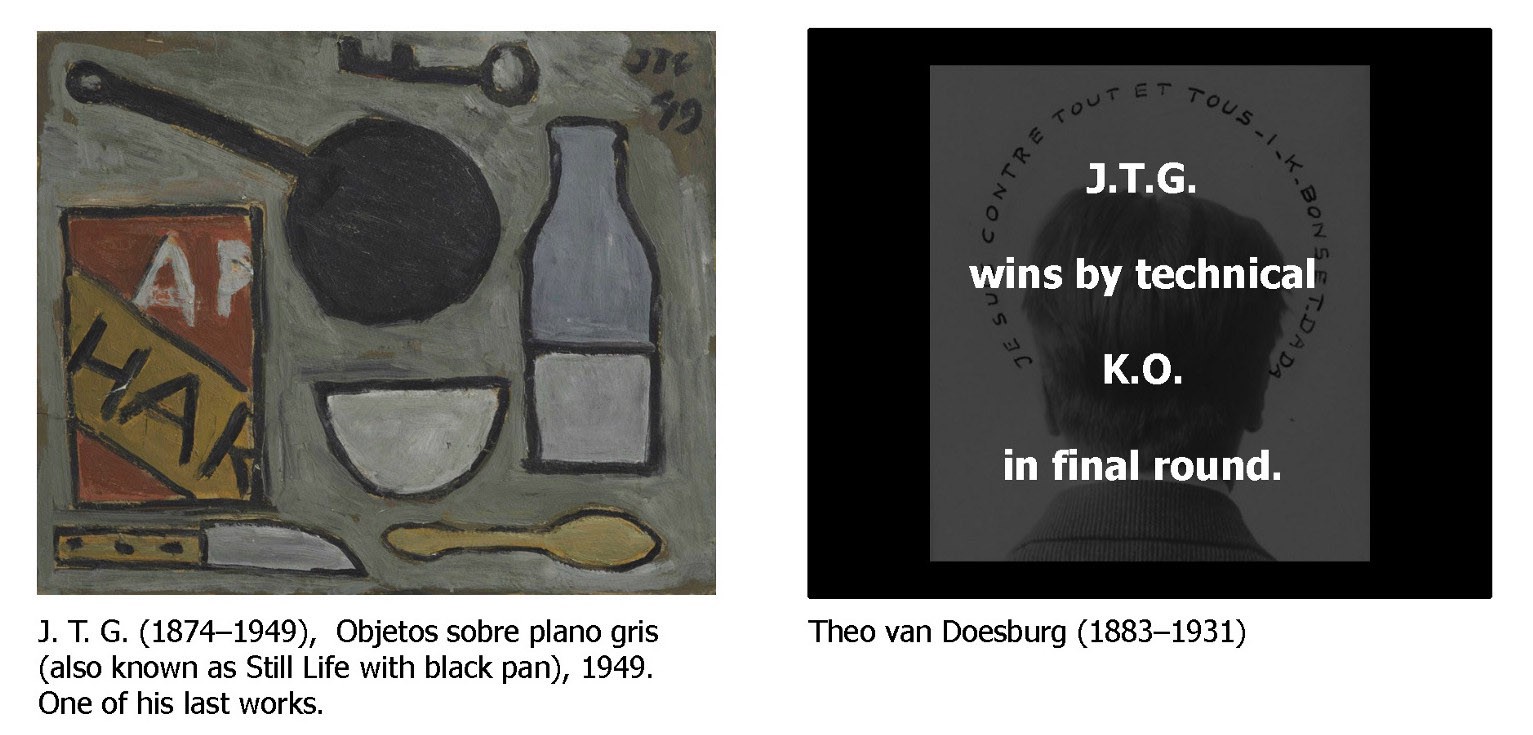
J.T.G. wins by technical K.O.
My last canvas, which I have been working on for a long time in black, white, and grey; a controllable structure, a fixed surface without coincidence or individual quirkiness.
Unimaginative? Yes.
Numb? Yes.
But not mindless, not universal-less and neither, I think empty, since it is everything that fits into the inner rhythm.
It is both the pyramid and the falling stone, as well as the rock over the water, Echo.
It is so Time as Space, the infinitely great as the infinitely small.
Thus, rich, and not poor.
[…]
This painting is still in the making and I hope to finish it soon.
— Letter Van Doesburg to Antony Kok (free-adaptation). 23.01.1930
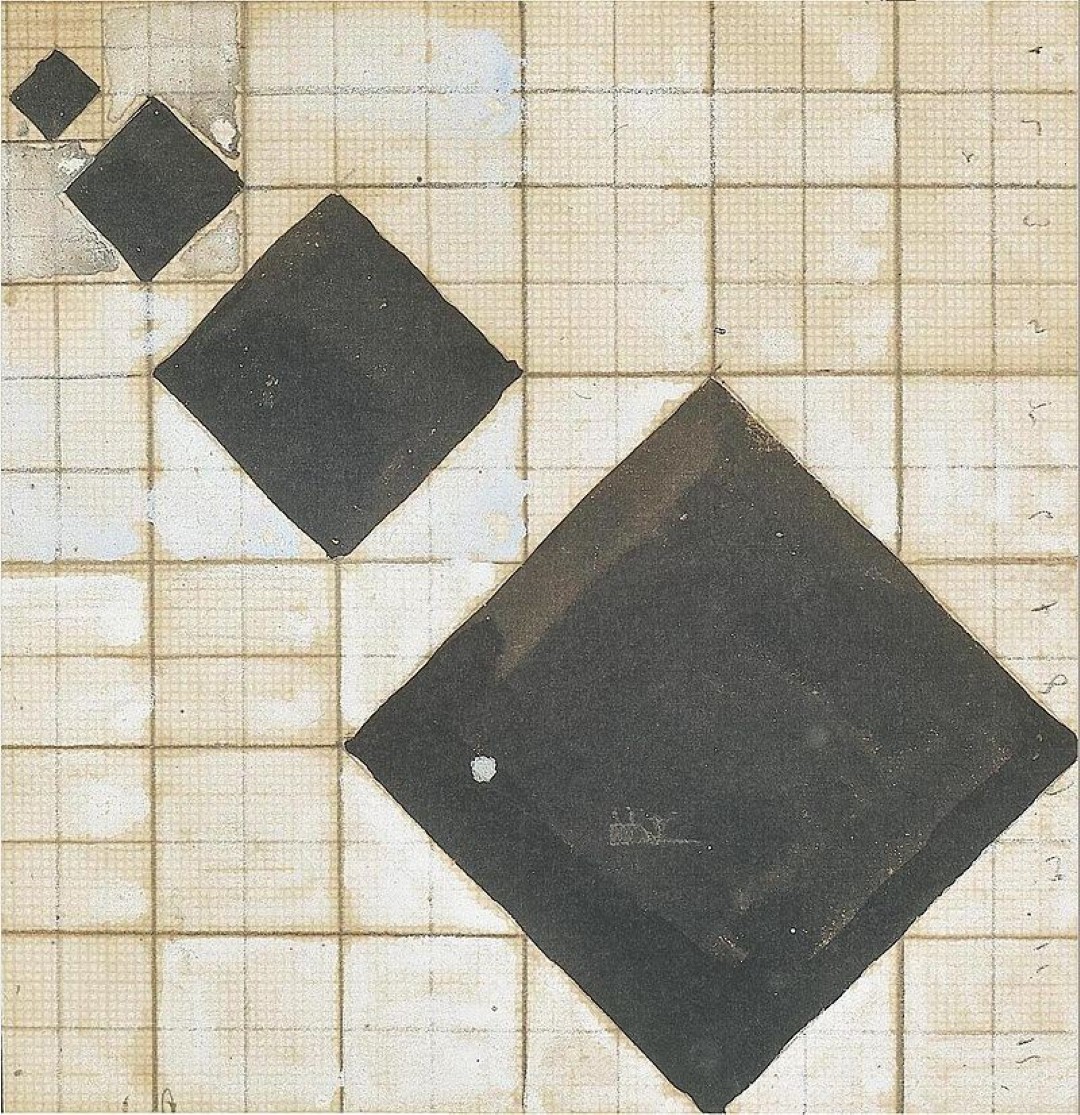
[K.O.] Theo van Doesburg (1883–1931) was increasingly debilitated by asthma and bronchitis which prevented him from working much after 1930. After a year of illness, he died on 7 March 1931, age 47, in a health clinic in Davos, Switzerland.
Theo famous last words were:
“In place of dreams the future will substitute art based on science and the technical, 1929”. — Super Abstraction Volume I, Constructive Readymades
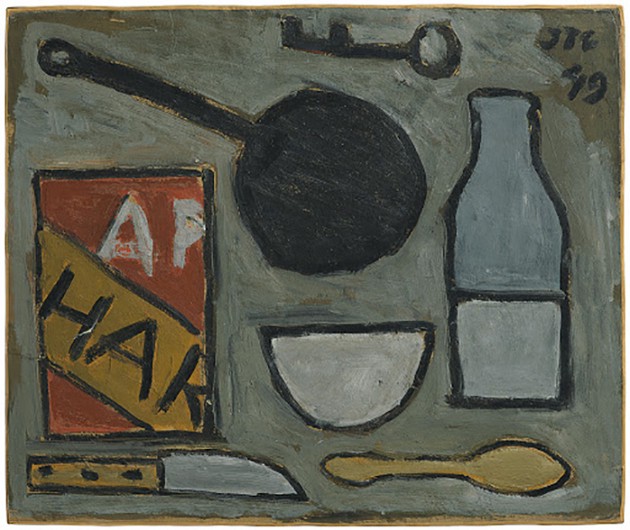
[Objetos sobre plano gris aka Still Life with black pan] Joaquín Torres García : Endeavors in exploring and understanding the 6th dimension {biological time} Transforming everyday objects in compositions of rough and simplified symbols.
* Medal “Dada” Toys
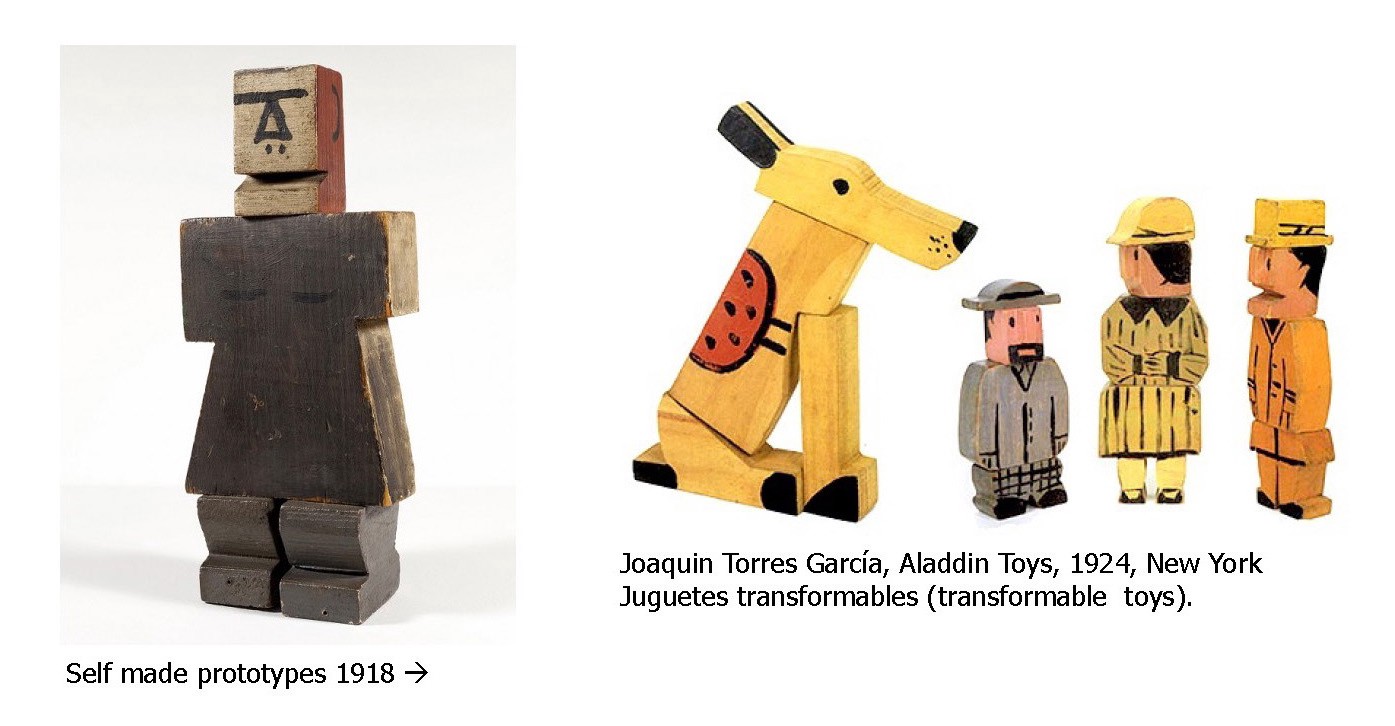
[Aladdin Toys] Toy-maker Joaquin Torres García started working on ideas for wooden transformable toys already before 1920. Going directly to the source of creativity; the imaginative reality of children in which abstract language plays a much bigger role.
[The Arcadian state]

JTG tried collaborating with manufacturing companies in Europe to produce the toys on a bigger scale, among Metz & Co,NL, but finally succeeded in New York. with Aladdin Toys, although it never became a commercial success. The New York warehouse burned down, with almost all his wooden toys inside of it.
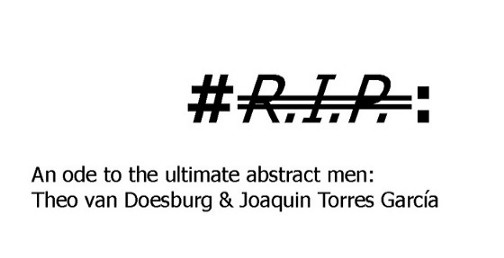
A dog's tale
It wasn’t the source of all meaning J.T.G. & Theo were chasing, it wasn’t the edge of the universe, it wasn’t heaven.
It was hope.
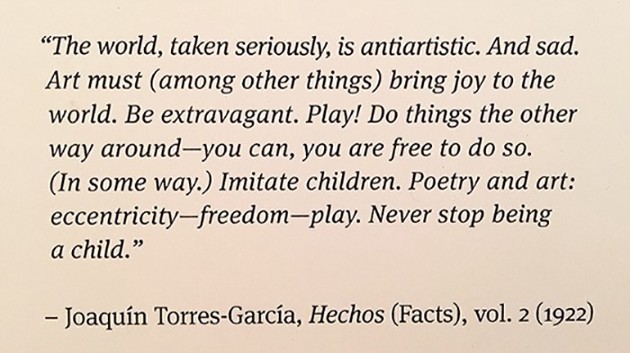
Their were chasing something for having something to chase, something to strive for. But just like a dog chasing its tale {tail}, what they wanted they already were.
“THERE’S NOTHING”, for art has always remained the child —
M., Towards prismatic thinking, 2025

Tonight’s fight! Van Doesburg vs J.T.G. A science-fictional-history lesson by © M. Production Published 02.2020 Triple-A Society
Exam Question
